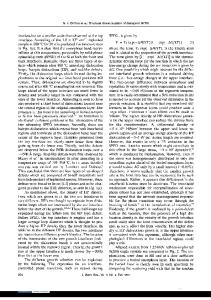Structural Characterization and Crystallization Process of Nanostructured Silicon Thin Films Produced in Low-Pressure Si
- PDF / 434,422 Bytes
- 6 Pages / 414.72 x 648 pts Page_size
- 48 Downloads / 330 Views
ABSTRACT
Nanostructured silicon thin films (ns-Si:H), consisting of a two-phase mixture of amorphous and ordered material, were obtained by plasma-enhanced chemical vapor deposition (PECVD) under a wide range of plasma conditions. The key to embedding Si-ordered particles in the amorphous Si matrix was the formation of silicon clusters in the gas phase (diameter < 2nm) under conditions of plasma polymerization, and their incorporation into the growing films. The crystallization induced by thermal annealing in these nanostructured films can be attained faster than in conventional a-Si:H thin films, because the silicon-ordered particles cause a heterogeneous nucleation process in which they act as seeds for crystallization. In this work, we present a detailed structural characterization by using electron and X-ray diffraction patterns and Raman spectroscopy. The crystallization dynamics were studied in-situ by Raman spectroscopy. INTRODUCTION Plasma-enhanced chemical vapor deposition (PECVD) is the most widely used technique to deposit hydrogenated amorphous silicon thin films (a-Si:H). When attempting to increase the deposition rate and the film quality of a-Si:H for industrial application, the onset of plasma polymerization is often considered as the main limiting factor for a-Si:H deposition.' However, just as polymerization begins, it is possible to obtain short-ordered Si thin films, between amorphous and microcrystalline, with improved transport properties and stability with respect to a-Si:H, similar optical properties and higher deposition rates."' The films consist of Si-ordered domains (1-2 nm) embedded in an amorphous Si matrix, as seen by high resolution transmission electron microscopy (TEM), 4 and they are formed by the incorporation into the growing film of Si clusters with a diameter below 2 nm, which are created in the discharge via the plasma polymerization reaction. 25 Due to the presence of these nanosized Si clusters in the films, we have called them hydrogenated nanostructured silicon (ns-Si:H). The Si clusters embedded in the amorphous matrix can be used as nucleation seeds in the crystallization of nano-, micro-, and polycrystalline silicon films on industrially relevant substrates. By using a controlled size and concentration of nanoclusters, it is possible to control the polycrystalline films formed by annealing. Indeed, conductivity measurements during heat treatment have already demonstrated that the crystallization of the ns-Si:H films is much faster than in standard a-Si:H films.4 This paper reports a detailed structural characterization of the as-deposited ns-Si:H and ofthe film after 933 Mat. Res. Soc. Symp. Proc. Vol. 507 01998 Materials Research Society
annealing at different temperatures (from the hydrogen desorption process until its crystallization) using Raman spectroscopy and X-ray diffiactometry. In addition, the crystallization of the ns-Si:H films was monitored in-situby Raman spectroscopy. EXPERIMENT Nanostructured silicon thin films were deposited on 7059 Coming glass in
Data Loading...



